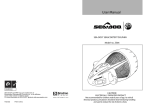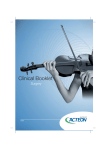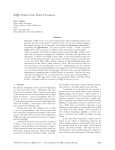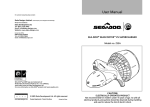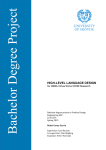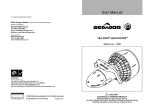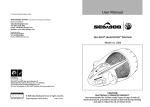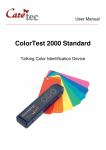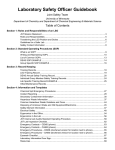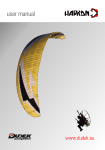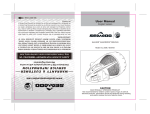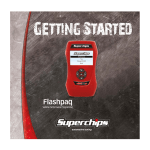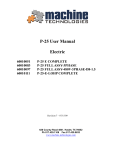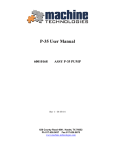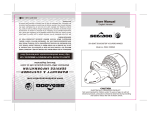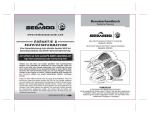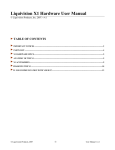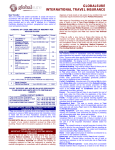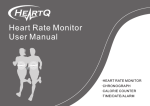Download STA Seascooter Programme Training Manual v1.0
Transcript
Seascooter Programme Teaching Manual Produced and published by the STA: STA Birch Street Walsall West Midlands WS2 8HZ Phone: 01922-645097 Fax: 01922-720628 Email: [email protected] Web: www.sta.co.uk All rights reserved. No part of this publication may be reproduced, stored in a retrieval system, or transmitted, in any form or by any means, electronic, mechanical, photocopying, recording, computerised or otherwise, without prior arrangement with the STA. 2 STA Seascooter Programme Teaching Manual Contents Teaching Programme Completion Declaration 5 5. Skills and Techniques ........................................19 1. The STA Seascooter Programme........................ 6 ‘Anti-Fogging’ of the Mask ...................................19 Acknowledgements ................................................6 Correct Fitting of the Mask and Positioning of the Strap.................................................................19 Introduction ..............................................................6 Prerequisites............................................................6 Physical Activity Readiness Questionnaire (PAR-Q)....................................................................6 Fitting the Fins.......................................................19 Clearing a Fogged Mask at the Surface............20 Equalising the Ears...............................................20 Pool Seascooter Sessions.....................................6 Skills........................................................................20 Awards......................................................................7 Games ....................................................................21 Pool Supervision .....................................................7 Races......................................................................21 Safety........................................................................7 Aquabatics .............................................................21 Pool Clothing ...........................................................7 STA Seascooter Level 1 Award Skills Check Sheet ..........................................................................23 Teacher to Student Ratio.......................................7 2. STA Seascooter Awards Criteria..................... 8 3. Equipment ........................................................... 11 Equipment ..............................................................11 WARNING..............................................................11 Getting Started ......................................................11 Battery Use ............................................................12 Care and Maintenance.........................................13 Trouble Shooting...................................................14 4. Support Equipment Requirements ................. 16 Minimum Requirements .......................................16 Masks .....................................................................16 Snorkels .................................................................16 Fins .........................................................................17 Cleaning and Hygiene..........................................17 STA Seascooter Level 2 Award Skills Check Sheet ..........................................................................24 STA Seascooter Level 3 Award Skills Check Sheet ..........................................................................25 Physical Activity Readiness Questionnaire (PAR-Q)..................................................................26 Physical Activity Readiness Questionnaire (PAR-Q) Tutors Guidelines .................................27 Physical Activity Readiness Questionnaire (PAR-Q) Doctor’s Letter.......................................28 Junior Physical Activity Readiness Questionnaire (J-PAR-Q) ....................................29 Junior Physical Activity Readiness Questionnaire (J-PAR-Q) Tutors Guidelines ....30 Junior Physical Activity Readiness Questionnaire (J- PAR-Q) Doctor’s Letter ........31 Equipment Safety..................................................17 Operations & Use..................................................17 STA Seascooter Programme Training Manual v1.0 STA © 2010 STA Seascooter Programme Training Manual 3 Teaching Programme Completion Declaration STA Seascooter Teaching Course Unit – Programme Details Candidates Name Membership Number Course Venue Course Date Course Tutor (1) Course Tutor (2) Pre-requisite Qualifications Teachers Qualification – Please STA Swimming Teacher Equivalent NaRS T/E Please provide details: Date Awarded: Expiry Date: Details of Pool Rescue Award – Please NaRS Pool Lifeguard NaRS Pool Safety Award Equivalent NaRS Pool Attendant NaRS Poolside Helper Please provide details: Date Awarded: Expiry Date: STA Seascooter Teaching Programme – Completion Declaration I confirm that the above named teacher has completed the STA Seascooter Teaching Programme Signed by the Tutor: Signed by the Candidate: Date: STA Seascooter Programme Training Manual v1.0 STA © 2010 4 STA Seascooter Programme Teaching Manual This Page Left Blank STA Seascooter Programme Training Manual v1.0 STA © 2010 STA Seascooter Programme Training Manual 5 Teaching Programme Completion Declaration STA Seascooter Teaching Course Unit – Programme Details Candidates Name Membership Number Course Venue Course Date Course Tutor (1) Course Tutor (2) Pre-requisite Qualifications Teachers Qualification – Please STA Swimming Teacher Equivalent NaRS T/E Please provide details: Date Awarded: Expiry Date: Details of Pool Rescue Award – Please NaRS Pool Lifeguard NaRS Pool Safety Award Equivalent NaRS Pool Attendant NaRS Poolside Helper Please provide details: Date Awarded: Expiry Date: STA Seascooter Teaching Programme – Completion Declaration I confirm that the above named teacher has completed the STA Seascooter Teaching Programme Signed by the Tutor: Signed by the Candidate: Date: STA Seascooter Programme Training Manual v1.0 STA © 2010 6 STA Seascooter Programme Teaching Manual 1. The STA Seascooter Programme Acknowledgements The STA wishes to thank the following individuals for their help in the production of this programme: • John Camm Introduction The STA Seascooter Programme is a series of 3 progressive awards, (Levels 1, 2 and 3) which are designed to introduce skills and techniques required for safe and enjoyable use of the Seascooter range in a pool environment. The STA recommends that if students wish to progress to Seascooter in open water, they must receive appropriate training and qualifications, from a scuba diving association such as the Professional Association of Diving Instructors (www.padi.com) or the British Sub Aqua Club (www.bsac.com). Prerequisites All participants must be over 8 years of age and competent swimmers. Competent Swimmers are defined as: Level 1 – Swimmers who are able to: 1. Swim unaided for at least 25m. 2. Tread water for 30 seconds. 3. Able to wear swimming goggles. Level 2 –: In addition to the skills above swimmers who: 1. Hold Pool Snorkelling Level 1. 2. Hold discover Seascooter Level 1 Certificate. Level 3 – in addition to the skills above swimmers who : 1. Hold Pool Snorkelling Level 2. 2. Hold Aquajet Racer Course. Physical Activity Questionnaire (PAR-Q) Readiness The Physical Activity Readiness Questionnaire (PAR-Q) is designed to identify the small number of people for whom physical activity might be inappropriate and those who should seek medical advice before commencing such activity. It is mandatory for candidates attending all NaRS and Manual Handling courses including Teacher/Examiner or Tutors courses. STA Seascooter Programme Training Manual v1.0 The PAR-Q SHOULD be given to candidates PRIOR to them attending any course and returned to the Tutor/Teacher for review. If this is not possible it MUST be completed by the candidate PRIOR to them commencing any type of physical activity and reviewed by the Tutor/Teacher. If students are under 16 years of age, they must have their parent/legal guardian complete the STA Junior PAR-Q and have their parent/legal guardian sign it. The form has a series of simple questions with either a ‘Yes’ or ‘No’ answer. Candidates must be encouraged to answer all questions honestly, however if they answer ‘Yes’ to any question the Tutor/Teacher should refer to the PAR-Q Tutors Guidelines for what actions to take. This may involve referring them to their Doctor before they are allowed to commence the course. To assist with this there is a PAR-Q Doctor’s Letter available as a download from www.sta.co.uk ; this is completed by the Tutor/Teacher and given to the candidate to take to his/her Doctor. Only if the Doctor’s consent has been given can the candidate be allowed to commence the course. If a candidate does not wish to complete the form, then it must be explained to him/her, that he/she will not be allowed to participate on the course. If you allow a candidate to participate on a course, then the STA will not be held liable in the event of any injury or accident. If the candidate still refuses to complete the form and you permit them to participate on the course, you will not be insured by the STA in respect of any claim made by, or relating to the candidate. Once completed the form and Doctors letters, and any information disclosed on it, MUST be treated with confidence. You can find the above mentioned forms on pages 26 to 31. Pool Seascooter Sessions Level 1 Award - Discover Seascooter This is an introduction to Seascooter, equipment, and its use. A minimum of 1 hour contact time is recommended before students are eligible to undertake the Level 1 award and progress to Level 2. A variety of different Seascooter games (depending on student ability) are recommended to develop confidence and add an element of fun to the sessions. Some suggested games are Bulldog, Hoop races, Egg & Spoon race, etc. STA © 2010 STA Seascooter Programme Training Manual Level 2 Award - Aquajet Racer This level reinforces the skills taught in the previous award, developing and introducing new skills. A minimum of 8 hours contact time is recommended before students are eligible to undertake the Level 2 award and progress to Level 3. Level 3 Award - Seascooter Aquabatics This advanced level reinforces the skills taught in the previous awards, developing skills and introducing Seascooter with a Partner. A minimum of 10 hours contact time is recommended before students are eligible to undertake the Level 3 award. Awards Students who successfully demonstrate competence in all the assessment criteria and achieve the prescribed learning outcomes will be eligible for the appropriate Seascooter Award (Levels 1-3). These are available for purchase in advance from the STA. 7 are taken to prevent injury. It is important to ensure equipment that student’s bring with them is safe and suitable for pool use. All participants (and their parent/guardian), must be warned of the risks associated with increased pressure on the ear drums when surface diving to depths greater than 1.5 metres. All participants must be taught how to equalise their ears before submersions below this depth are allowed. Students suffering from any infections/illnesses that block the sinuses must not participate in submersion activities. Pool Clothing If you are in the water demonstrating skills, then you must wear appropriate clothing. Due to the skills required to be taught on this course, a t-shirt is not suitable to wear in the water. A suitable alternative is an item such as a rash vest. Note: Skills check sheets on pages 23 to 25 can be photocopied (and laminated) as an aid memoir for poolside. Pool Supervision The teacher is responsible for the safety of the students and should be satisfied that there is adequate and competent lifesaving cover available; this could be the teacher provided that he/she is properly trained and has assessed the risks. If the teacher is in the water with the students STA recommend separate lifesaving cover on poolside. Teacher to Student Ratio A maximum ratio of one qualified STA Seascooter Programme Teacher to 16 students is recommended. Safety Teachers are responsible for the safety and welfare of those in their care and must ensure that all steps STA Seascooter Programme Training Manual v1.0 STA © 2010 8 STA Seascooter Programme Teaching Manual 2. STA Seascooter Awards Criteria Seascooter Level 1 Award Teaching Objectives Introduce: • Pool rules and regulations. • Hygiene. • Water safety. • Preparation and use of equipment. • Correct and safe entries and exits. • Spatial awareness. • Swimming techniques. • Playing games. Learning Outcomes Assessment Standards 1. Show the correct use of Seascooter controls-stopping and starting. Under guidance turn the Seascooter on. From standing, correctly position hands on triggers. Move forward in correct body position for 5m and come to a stop. 2. Perform a right and left turn. Travel forward for 5m, steer right, maintain the course for 5m, steer left, maintain the course for 5m and stop. 3. Perform a complete and full circle. Navigate a 5m diameter circle on or near the surface. Options: Place a floating mat, sinking markers or submersible hoops to mark the course. 4. Navigate a figure of ‘8’ course. Steer a horizontal figure of ‘8’ on or near the surface, incorporating right and left hand turns with a cross over in the middle. Options: Place floating mats, sinking markers or submersible hoops to mark the course. 5. Participate in a Seascooter game. Suggested activities: Individual and team races, time trials, slalom, bulldog or similar.(See page 21 ) STA Seascooter Programme Training Manual v1.0 STA © 2010 STA Seascooter Programme Teaching Manual 9 Seascooter Level 2 Award Teaching Objectives Reinforce: • Hygiene • Pool Rules and regulations. • Water safety. • Spatial awareness. Introduce: • Clearing a mask. • Equalisation Techniques. • Breathe holding & relaxation techniques. • Ascending safely. • Surface diving techniques. • Negotiate obstacles. Develop: • Preparation and fitting of equipment. • Swimming techniques. • Playing games. Learning Outcomes Assessment Standards 1. Show the correct use and control of a Seascooter. Steer a figure of eight, on or near the surface to show left and right hand turns with ability to stop. 2. Perform a surface dive through a hoop. Suggested minimum depth of 1.2m. Travel forward for 5m, submerge, clearly pass through hoop, ascend to the surface and continue forward for 2m. 3. Navigate a slalom course. Minimum of 4 markers to layout slalom course with a minimum of 3m between markers. Options: incorporating going through hoops or round markers. 4. Participate in an individual Seascooter game. See Games/Races/Aquabatics section for suggestions. (See page 21) 5. Participate in a team Seascooter game. See Games/Races/Aquabatics section for suggestions. (See page 21) STA Seascooter Programme Training Manual v1.0 STA © 2010 10 STA Seascooter Programme Teaching Manual Seascooter Level 3 Award Teaching Objectives Reinforce: • Skills learnt in previous awards. Introduce: • Working with a Partner. Develop: • Breathing techniques. • Swimming techniques. • Communication. • Playing games. Learning Outcomes Assessment Standards 1. Show the correct use and control of a Seascooter. Horizontal figure of eight to include two full submersions. 2. Perform a Barrel Roll. While fully submerged travel forwards for 10m performing a corkscrew action through the water in a horizontal plane. 3. Perform a Front somersault. 4. Perform a Back somersault. 5. Perform a figure of ‘8’. 6. Perform a freestyle routine. 7. Perform a synchronised routine with a partner. STA Seascooter Programme Training Manual v1.0 Depending on the water depth this can be performed in a horizontal or vertical plane. With the body in a pike or semi-pike position complete a 360 degree circle returning to the start position. Depending on the water depth this can be performed in a horizontal or vertical plane. With the body in a backward arched position complete a 360 degree circle returning to the start position. In a horizontal plane perform a piked half front somersault, turning into an arched full back somersault, followed by a piked half front somersault. A continuous routine to be performed in a vertical or horizontal plane depending on water depth; for a minimum of 1min and to include at least 3 elements from skills within the syllabus. With a partner perform a continuous routine in a vertical or horizontal plane depending on water depth; for a minimum of 2mins incorporating a minimum of 3 elements. STA © 2010 STA Seascooter Programme Teaching Manual 11 3. Equipment Equipment • • • • SEA-DOO® SEASCOOTER™ GTI Parts Diagram 1) 2) 3) 4) 5) 6) 7) 8) 9) 10) 11) 12) 13) 14) 15) 16) 17) 18) Latch Nose Cone Inner Nose Cone Vent Plug Trigger Handle Nozzle Propeller Protective Grilles Battery Housing Master Switch Battery Leads Battery Vent Hole Buoyancy Control Chamber Silicone Ring Pump Lubricant WARNING • • • • Read the User Manual carefully. Never remove the grilles except for maintenance. Never stick body parts, clothing or other objects in the vicinity of the Propeller. Do not wear loose or flowing clothing or equipment that could be drawn into the Propeller. Particular care should be exercised when using the SEA-DOO® SEASCOOTER™ GTI near anybody with long hair. Users with long hair should tie it up or wear a swimming cap when using the SEADOO®SEASCOOTER™ GTI. STA Seascooter Programme Training Manual v1.0 • • • • • • • • Always inspect the swimming area to ensure it is free of hazards or obstacles such as boats and swimmers before using the SEADOO® SEASCOOTER™ GTI. Always charge battery to its fullest before using the SEA-DOO® SEASCOOTER™ GTI. Ensure sufficient battery charge remains for return to shore or surface. Always wear a coast guard approved personal flotation device when using the SEA-DOO® SEASCOOTER™ GTI. Be aware of appropriate water levels, tidal changes, dangerous currents, weather changes and strong offshore winds. Always scout unfamiliar water. Do not use alcohol or mind-altering drugs prior to using this product. ALWAYS keep the SEADOO®SEASCOOTER™ GTI out of direct sunlight when not in use. HEAT KILLS BATTERIES. When using the SEADOO®SEASCOOTER™ GTI for SCUBA, ascents and descents should be made in accordance with recognized diving practices. The SEA-DOO® SEASCOOTER™ GTI should only be used for SCUBA by qualified divers. Always follow this age recommendation: a child under 16 years old should never operate this SEA-DOO® SEASCOOTER™ GTI in the sea. Never open the Cover of the SEA-DOO® SEASCOOTER™ GTI in the water. When not in use, always turn the Master Switch to the off position. Do not use the SEA-DOO® SEASCOOTER™ GTI below the recommended maximum depth of 30m/100ft. Getting Started When you use the SEA-DOO® SEASCOOTER™ GTI for the first time, the battery needs to be charged. Follow the instructions in "Battery Use", for charging and connection. Your SEA-DOO® SEASCOOTER™ GTI can be used for swimming, snorkelling and diving up to 30m/100 ft. but will need to be adjusted for neutral buoyancy. The SEA-DOO® SEASCOOTER™ GTI should be kept positively buoyant – this is done by STA © 2010 12 STA Seascooter Programme Teaching Manual simply making sure the Buoyancy Chamber is empty and fitted inside the Nose Cone. Using the SEA-DOO® SEASCOOTER™ GTI for Swimming and Snorkelling 1. Charge the battery – make sure that when you finish the Vent Plug is closed. 2. Place the SEA-DOO® SEASCOOTER™GTI into the water so the Handle, Outer Nose Cone and Nozzle are filled with water. 3. When ready, switch the Master Switch to the ON position (see Fig.2). 4. Pull and hold Triggers to start the Propeller. (There is a short delay before the Propeller begins to rotate). 5. To stop the Propeller, simply release the trigger. 6. Always turn the Master Switch OFF when out of the water. 7. Maintain proper posture as shown below when using the SEA-DOO® SEASCOOTER™ GTI to achieve the maximum speed (See Fig.3). Battery Use Charging the Battery For battery charging follow these instructions: 1. Always ensure that the Master Switch is OFF (See Fig.2). 2. .Always ensure that the SEA-DOO® SEASCOOTER™ GTI is out of the water and placed in a dry area. 3. Give a half turn to the Latches and remove them from the Nose Cone as shown in Fig.4. STA Seascooter Programme Training Manual v1.0 4. Remove the Outer Nose Cone and Buoyancy Control Chamber. 5. Open the Vent by unscrewing the Vent Plug. 6. Remove the Inner Nose Cone. To do this, first feed the silicone ring (provided with this manual) through the latch holes in the Inner Nose Cone and hook over the hooks on the Battery Housing (See Fig.6). Then screw the Pump Nozzle onto the Vent Hole and pump air into the Battery Chamber until the Inner Nose Cone pops off and then remove the silicone ring. 7. Allow two minutes for any gasses to dissipate. 8. Disconnect the battery cable from the housing cable by pressing the locking feature (See Fig.7). (The battery cable is disconnected when you first buy your SEADOO® SEASCOOTER™ GTI 9. Connect the battery cable to the charger cable. 10. Plug charger into mains, and turn on the supply. Do not replace the Nose Cone. 11. Charging will take 4 to 6 hours for a fully discharged battery. When the battery is charging the LED charger remains on, when the battery is charged the LED flashes. 12. Unplug the adapter from the mains. 13. Unplug the battery cable from the charger cable and reconnect to the housing cable. 14. Make sure the seals and sealing surfaces are clean and lubricated before replacing the Inner Nose Cone (See Fig.8). STA © 2010 STA Seascooter Programme Teaching Manual 15. Replace the Inner Nose Cone making sure the key is aligned correctly (See Fig 9). 16. Ensure the Vent O Ring is clean, lightly greased and fitted correctly (See Fig.10). 17. Screw in the Vent Plug to seal the vent. 18. Replace the Buoyancy Control Chamber. 19. Replace the Outer Nose Cone making sure the key is aligned correctly and insert the Latches and lock the Nose Cone by giving them a half turn (See Fig.11). 13 Re-charging the Battery Follow steps 1 to 6 in “Battery Use” section to open the SEADOO® SEASCOOTER™ GTI. 1. The unit must be dried before it is disassembled. 2. The charger should be placed on a dry horizontal surface when charging the battery. 3. The battery charger operates at 230 volts and should never be handled with wet hands. 4. Once charged, store the battery in a horizontal position in a dry place ready to be used again. 5. If the Seascooter is not in constant use then re-charge the battery every three months. 6. Using a timer to time the charge cycle of the batteries will prolong the batteries working life. 7. Please see Care and Maintenance Section. To replace a Flat Battery with a Fully Charged Battery 1. Follow steps 1 to 6 in "Battery Use" section, to open the SEADOO® SEASCOOTER™ GTI. 2. Unplug the battery at the socket by pressing the locking feature shown in Fig.7. 3. Remove the flat battery. 4. Install and connect the charged battery in the correct position - the leads of the battery must be oriented as shown on the sticker on the battery (See Fig.12). 5. Follow steps 14 to 19 in "Battery Use", to close the SEA-DOO® SEASCOOTER™ GTI. Buying Parts Additional batteries can be purchased separately. Contact your dealer to purchase them. Care and Maintenance Note: To charge a battery outside of the unit, simply connect to the charger, then plug the charging adapter into the mains. When the battery is charged, unplug the adapter first then battery. STA Seascooter Programme Training Manual v1.0 Battery Care • The battery should be recharged as soon as possible after use. • If the unit is not used for extended periods, the battery should be removed from the unit and charged overnight every three months. • Only use the charger supplied with the SEADOO® SEASCOOTER™ GTI. • Never place the battery in a sealed container when charging. STA © 2010 14 STA Seascooter Programme Teaching Manual • • • • Never short circuit the battery or battery cable. Never place/store the battery near a radiator/fire, etc. To store the battery, remove it from the SEADOO® SEASCOOTER™ GTI or separate it from charger, insulate the battery terminals and keep in a place that is dry and cool. Ambient temperature for storage should be within the range -20˚C to 40˚C (-4˚F to 104˚F). Care after Using the SEADOO® SEASCOOTER™ GT • • • • • • • Always rinse the SEADOO® SEASCOOTER™ GTI in fresh water immediately and allow it to dry before storage. To clean the SEADOO® SEASCOOTER™ GTI do not use detergents, only use a damp cloth to wipe the unit clean. The Battery Housing interior should be kept dry at all times. If the Battery Housing interior ever gets wet.(See Accidental Flooding Section). When storing the SEADOO® SEASCOOTER™ GTI for extended periods of time, open the Vent Plug in the Inner Nose Cone. Always store your SEADOO® SEASCOOTER™ GTI vertically in a dry room when not in use to prevent deformation of the Propeller Nozzle. Prolonged periods of horizontal storage will distort the propeller housing. This can cause the propeller to foul against the housing and stop it from turning. Do not keep the SEADOO® Seascooter™ GTI in its bag when wet with the battery charging unit. THIS WILL CAUSE IRREPARABLE DAMAGE TO THE BATTERY CHARGER Grille. If this is not possible the back Grille and Propeller can be removed. Under normal use the Grilles must not be removed. Removing the front Grille to remove an obstruction: 1. Remove the SEADOO® SEASCOOTER™ GTI from the water. 2. Make sure the master switch is in the OFF position. 3. Insert a screw driver as shown in Fig 13 to remove the two Grille pins. 4. Unclip Grille as shown in Fig 14. 5. Remove obstruction. 6. Reassemble Grille and insert clips. Removing rear Grille and Propeller to remove obstruction: Remove the SEADOO® SEASCOOTER™ GTI from the water. 1. Make sure the master switch is off. 2. Remove the battery. 3. Unscrew the six rear Grille screws as shown in Fig 15. Trouble Shooting Unit Does Not Function If the motor does not start when both triggers are pressed, make sure: 1. The battery is properly connected. 2. The battery is fully charged (See Charging The Battery Section). 3. The mater switch is in the “On” position (See Fig 2). 4. There is no water in the battery compartment (See Accidental Flooding Section). Blocked Propeller If the Propeller becomes blocked first try and remove the obstruction by removing the front STA Seascooter Programme Training Manual v1.0 4. Whilst holding the Propeller, use an M6 socket to remove the nut from the Propeller shaft (See Fig 16). STA © 2010 STA Seascooter Programme Teaching Manual 15 Sand or Grit in Seals Sand or grit is the enemy of seals. Correct maintenance and care is essential. To remove sand or grit from the seals, rinse the seals in fresh water and apply fresh lubricant. If there is sand inside the Battery Housing, gently brush the sand from the unit taking care not to scratch the sealing surfaces. 5. Slide the Propeller off the shaft, taking care not to loose the drive pin or washers. 6. Remove the blockage from the Propeller. 7. Replace the drive pin (if removed), see Fig 17, and Propeller. Turn the Propeller slowly until you locate the pin and push the Propeller fully on. 8. Replace the washer(s) and nut and tighten with the socket whilst holding the Propeller making sure it is securely fastened (See Fig 18). 9. Replace the Grille. 10. Replace the Battery. SEADOO® SEASCOOTER™ GTI Cuts Out To protect the electronic circuit of your SEADOO® SEASCOOTER™ GTI from damage a safety mechanism has been built in that cuts the power if a wall or rock or other immovable object is hit. If this occurs simply wait for a short period to allow the SEADOO® SEASCOOTER™ GTI to reset itself and resume use. Accidental Flooding Be sure to keep the seals sand and grit free to ensure they keep water out and to close the vent plug after accessing the battery chamber. However, should the seals not be clean or the vent plug left open and water enter the battery chamber, your SEADOO® SEASCOOTER™ GTI will not be damaged as it is designed for protection against accidental flooding. If water enters the battery chamber the SEADOO® SEASCOOTER™ GTI will automatically stop functioning. If this occurs: 1. Remove the unit from the water. 2. Open the battery chamber, remove the battery and if salt water has entered rinse it out with fresh water. 3. Dry the battery chamber and battery thoroughly and reassemble, ready for use. STA Seascooter Programme Training Manual v1.0 STA © 2010 16 STA Seascooter Programme Teaching Manual 4. Support Equipment Requirements Minimum Requirements • • • • • Mask – One per student. Snorkel – One per student. Fins – One pair per student. Weighted hoops for swimming through. Objects to pick up from pool floor. lenses. You must however, ensure that all masks used have a tempered glass lens plate(s). If these are broken, the glass is less likely to shatter into hazardous slivers. Most new masks are coated with a protective film that you will need to remove; otherwise you will not be able to defog it. To remove the film clean the lens with a soft cloth and tooth paste (nongel) or a similar low abrasive cleaner. Warning: The above only applies to standard tempered glass masks, not to non-fog or prescription masks. Before scrubbing any diving mask, read the printed material that accompanies it. Anti-fog and some prescription masks can have plastic inserts which may be severely damaged by even mildly abrasive substances like toothpaste. These masks will usually be supplied with their own cleaner/defogger solutions. Fitting a Mask To test if a mask fits correctly, place it against the face and breathe in through the nose. The vacuum created in the mask should hold it against the face when the hands are taken away. If the mask does not stay in place repeat the process with other masks until a suitable one is found. Snorkels Note: Hoops and submersible objects are available through www.staswimshop.com Masks Masks are designed to create an airspace which allows the eyes to focus underwater. As there is an airspace, they also need to enclose your nose to allow you to equalise the pressure in the mask, which may be felt during submersions. Masks come in a wide variety of sizes, colours and styles and vary from single to double panel STA Seascooter Programme Training Manual v1.0 Snorkels are for breathing air from above the water surface when the user's mouth and nose are submerged. They come in a variety of colours and styles, usually with an attachment to secure them to the mask strap. Snorkels should be chosen based on comfort and appropriate fit for the size of the individual’s mouth, and for minimal breathing resistance. The snorkel should not rub the lips or gums and cause the jaw to become tired. You should be STA © 2010 STA Seascooter Programme Teaching Manual able to relax your jaw without losing the mouthpiece. The snorkel should always be fitted onto the left side of the mask. (If students progress from snorkelling to scuba diving then this fitting method prevents the snorkel from interfering with the regulator), using a clip or snorkel keeper. Adjust it, so the top of the snorkel sits at the crown of the head, with the mouthpiece in place. A good snorkel should: • Have a large bore – so it’s not like breathing through a straw. • Not be too long – it is harder to clear and you will be re-breathing a lot of expired air. 43cm/17 inches is a suitable length. • Be designed with smooth, rounded bends – sharp bends add breathing resistance. • Contour to the shape of the head – this will help minimise drag in the water. Many modern snorkels also have additional features: • A self draining feature – making it easier to clear water from a snorkel. • A flexible lower portion – this allows the mouthpiece to drop away from the mouth when not required. • A splash guard – to keep the snorkel dry. Warning: Snorkels create a "dead air space", during use some of the previously exhaled air remains in the snorkel and is recycled into the lungs. This reduces the breathing efficiency and may cause carbon dioxide (CO2) retention; at high levels this can cause shortness of breath, headache, confusion and possible drowning. Fins Fins come in a variety of different shapes, features and colours, but they all have pockets for the feet and blades for propulsion. They provide a large surface area to allow a person to use their leg muscle to propel them through the water. Modern fins come in two basic styles: 17 Full foot – these enclose the heel and fit like a rubber shoe. When fitting these they should feel comfortable, but not loose. Adjustable strap – these are required to be worn with neoprene footwear. They have an open heel and an adjustable strap to secure them in place. Cleaning and Hygiene Following each session it is the teacher’s responsibility to ensure that all Seascooters, masks, fins and snorkels are thoroughly rinsed and sanitised with fresh water in accordance with manufacturer’s recommendations (See Care and Maintenance). Equipment Safety It is the teacher’s or lifeguard’s responsibility to ensure that all equipment is safe to use prior to each session. This includes checking mask straps and lens plates, snorkel mouthpieces and fin pockets/ straps and buckles prior to each session. The serviceability of SEADOO® SEASCOOTER™ GTI equipment is a must to ensure safety of both the user and the. SEADOO® SEASCOOTER™ GTI Operations & Use Seascooter must only be used by children under 16 years of age, whilst under the direct supervision of a Qualified Swimming Teacher or Lifeguard. The following rules must be adhered to: • The Seascooters weight is up to 15 kilos and should be carried to the Swimming Pool area by the supervising adult and carefully placed into the water ready for use. • Never allow the unit to slam into the pool whilst holding the nose cone. • All riders must wear conventional swim wear, with no loose clothing. • All long hair must be tied back or swimming hats worn. • No necklaces or jewellery to be worn. • All waist belts or ties must be on the inside of any trunks or shorts. • No persons can operate a Seascooter whilst chewing gum. • Both hands must be on the controls at all times. • The Riders arms must be extended and the Seascooter Propeller must be in front of the rider at all times. The Swimming Teacher / Lifeguard must ensure the following: STA Seascooter Programme Training Manual v1.0 STA © 2010 18 STA Seascooter Programme Teaching Manual • • • All riders must travel in the same direction around the swimming pool. Riders do not crash into the swimming pool sides. Riders do not crash into one another. Propeller Obstruction Cords caught around the Propeller will severely affect the Seascooters overall performance and if left will burn out the motor in minutes. This is an expensive repair and is not covered under warrantee. STA Seascooter Programme Training Manual v1.0 Removal of Seascooter from the Swimming Pool They must be carried out by the supervising Swimming Teacher or Lifeguard and the units be carried back to the storeroom for recharging. Any faulty units must be returned to Alpha Distribution immediately. The quicker the units are sent the cheaper the service charge will be. Water left inside the unit will corrode the working parts very quickly. STA © 2010 STA Seascooter Programme Teaching Manual 19 5. Skills and Techniques ‘Anti-Fogging’ of the Mask You can purchase a commercially prepared defogging solution from any scuba diving retailer. Squeeze a drop or two onto the inside lens of the mask and gently rub the solution around to cover the inside completely. • Hold the mask against your face. • Pull the strap over your head and position it at the widest section of your head, which is at the top of the back of your head. • Ensure that the skirt is not folded or creased. Your partner can do this for you. Dip the mask briefly into water, swirl the water around the inside of the mask very quickly and empty the water from it. • Make sure it fits comfortably around your eyes and nose. Fitting the Fins For full foot fins, prepare them by folding the back of the fin underneath itself. Alternatively use a natural defogging solution, your saliva. Your saliva will prevent your mask from fogging just as well as any commercial defogging solution. The enzymes in your saliva stick to the lens of your mask like a commercial solution. Correct Fitting of the Mask and Positioning of the Strap Then, either sit down and put your foot in your lap or if standing up, place a hand on your partners shoulder and have them do the same to you. Put your foot in the fin, then either roll up the rear lip over your heal, for the full foot fin, or pull the strap up and snap it into place for the strapped model. • Fold the strap over the front of the mask so that it is out of the way. STA Seascooter Programme Training Manual v1.0 STA © 2010 20 STA Seascooter Programme Teaching Manual Clearing Surface a Fogged Mask at the • If you feel pain, you have already descended too far. Stop and ascend. • Equalise early and often. Other methods which can be used are: • Pinch the nose and swallow. • Swallow and wiggle the jaw. • A combination of all the techniques. Skills Right turn-Travel forward for 5m and steer right. • Let a little bit of water into the mask by pulling the corners of the bottom of the skirt away from your face. Left turn-Travel forward left for 5m and steer left. • Re-seal the mask on your face, then look down so the lens surface is horizontal and swish the water around to rinse away the fog. Complete full circle-Navigate a full circle on or • Pull the skirt out again to let the water out, while looking upwards. Figure of ‘8’-Steer a horizontal figure of ‘8’ on or near the surface. near the surface, incorporating left and right hand turns with a cross over in the middle. Equalising the Ears When submerging under water, pressure is placed between the middle and outer ear. Surface dive-Travel forward 5m from the The process of "clearing ears" or equalising pressure between the middle and outer ear is a very important skill. Barrel roll-While fully submerged travel 10m The most popular and widely used technique is called the Valsalva Maneuver. Spiral roll-Travel forward whilst rotating on your longitudinal axes perform a 3 dimensional corkscrew action through the water poolside. performing a lateral roll on longitudinal axes action through the water. Front somersault-Depending on the water depth, this can be performed in a horizontal or vertical plane Back somersault-Depending on the water depth, this can be performed in a horizontal or vertical plane Rocket-Streamlined body position turning left and right-travel through the water with the body stretched out. To perform this, you close your mouth, pinch your nostrils closed with your thumb and forefinger and gently blow through your nose. Inverted rocket-Streamlined-Inverted body position-travel through the water with the head facing the bottom of the pool. Safety Notes • If you blow too hard it is possible to rupture your ear drum. STA Seascooter Programme Training Manual v1.0 STA © 2010 STA Seascooter Programme Teaching Manual Games Underwater Football • Teams of five compete against each other by pushing around a weighted football. • They have to score in opposition’s net. • No hands, scooter only. Bulldog • Everyone has a Seascooter. • One person starts in the middle of the pool as a dog and has to catch people while they try to get from one side of the pool to the other. • When a person is caught, they also become a dog. • Play until last person standing, who’s the winner. Relay • Teams of two, four or six people. • Designated markers are placed underwater at each end of the pool 2m away from the wall. • Team members take up a position at either end of the pool. • Each person in the team has to complete a length of the pool. • Once they have passed the designated marker the next team member follows on. • The first team to complete all lengths is the winner. Tag • One swimmer will be named ‘Tag’ to start the game. • They then have to catch a person who will become the ‘Tag’ who has to catch another person. • Continue the game in this manner for as long as you choose. Races All races can be individual or team events. The distance of these events must be achievable by the weakest swimmer. 21 Hoop Race Race down the pool and back, negotiating Hoops mounted on the surface. Hoop Race Bottom Race down the pool and back, negotiating Hoops mounted on the bottom. Mixed Hoop Race Race down the pool and back, negotiating Hoops mounted on the bottom and at the surface. Slalom Race Race down the pool and back, negotiating Slalom’s. Slalom & Hoop Race Race down the pool and back, negotiating Slaloms and Hoops. Egg & Spoon Race • Race down the pool and back, while balancing a small weighted object (egg) on the front of the Seascooter. • Hoop race down the pool and back, while balancing a small weighted object (Egg) on the front of the Seascooter. • Hoop race down the pool and back, while balancing a small weighted object (Egg) on the front of the Seascooter. Advanced Hoop Race Race down the pool and back, negotiating Hoops mounted on the bottom and at the surface. A challenge is also undertaken on each hoop for example, a back somersault. Advanced Slalom Race Race down the pool and back, while negotiating Slalom’s. A challenge is also undertaken at each slalom, for example, a back somersault. Advanced Slalom & Hoop Race Race down the pool and back, negotiating Hoops & Slaloms mounted on the bottom and at the surface. A challenge is also undertaken on each hoop for example, a back somersault. Aquabatics Straight Race Simple Race can be done lengths or widths. STA Seascooter Programme Training Manual v1.0 A swimming pool is a three dimensional, weightless area and therefore the possibilities are endless. STA © 2010 22 STA Seascooter Programme Teaching Manual We suggest that manoeuvre’s are done on the vertical plane in water deeper than 1.8metres. If the water is shallower, we suggest that the tricks are performed on the horizontal plane, with the swimmer on their side. Manoeuvre’s to Practice • Single Back Somersault, Straight, pike or tucked. • • Single Front Somersault, Straight, pike or tucked. • Multiple Back Somersault, Straight, pike or tucked. • Side Rocket, Left and Right. • Inverted Rocket. Multiple Back Somersault, Straight, pike or tucked. STA Seascooter Programme Training Manual v1.0 STA © 2010 STA Seascooter Programme Teaching Manual 23 STA Seascooter Level 1 Award Skills Check Sheet Learning Outcomes 1. Show the correct use of Seascooter controls-stopping and starting. 2. Perform a right and left turn. Assessment Standards Under guidance turn the Seascooter on. From standing, correctly position hands on triggers. Move forward in correct body position for 5m and come to a stop. Travel forward for 5m, steer right, maintain the course for 5m, steer left, maintain the course for 5m and stop. 3. Perform a complete and full circle. Navigate a 5m diameter circle on or near the surface. Options: Place a floating mat in the centre of the circle, or: bricks on the circumference to mark the course. 4. Navigate a figure of ‘8’ course. Steer a horizontal figure of ‘8’ on or near the surface, incorporating right and left hand turns with a cross over in the middle. Options: Place floating mats, sinking markers or submersible hoops to mark the course. 5. Participate in a Seascooter game. Suggested activities: Individual and team races, time trials, slalom, search and recover or similar.(See page 21) STA Seascooter Programme Training Manual v1.0 STA © 2010 24 STA Seascooter Programme Teaching Manual STA Seascooter Level 2 Award Skills Check Sheet Learning Outcomes Assessment Standards 1. Show the correct use and control of a Seascooter. Steer a figure of eight, on or near the surface to show left and right hand turns with ability to stop. 2. Perform a surface dive through a hoop. Suggested minimum depth of 1.2m. Travel forward for 5m, submerge, clearly pass through hoop, ascend to the surface and continue forward for 2m. 3. Navigate a slalom course. Minimum of 4 markers to layout slalom course with a minimum of 3m between markers, incorporating going through hoops & round markers. 4. Participate game. in an individual Seascooter 5. Participate in a Seascooter team game. STA Seascooter Programme Training Manual v1.0 See Games/Races section for suggestions. (See page 21) See Games/Races section for suggestions. (See page 21) STA © 2010 STA Seascooter Programme Teaching Manual 25 STA Seascooter Level 3 Award Skills Check Sheet Learning Outcomes Assessment Standards 1. Show the correct use and control of a Seascooter. Horizontal figure of eight to include two full submersions. 2. Perform a Barrel Roll. While fully submerged travel forwards for 10m performing a corkscrew action through the water in a horizontal plane. 3. Perform a Front somersault. Depending on the water depth this can be performed in a horizontal; or vertical plane. With the body in a pike or semi-pike position complete a 360 degree circle returning to the start position. 4. Perform a Back somersault. Depending on the water depth this can be performed in a horizontal; or vertical plane. With the body in a backward arched position complete a 360 degree circle returning to the start position. 5. Perform a figure of ‘8’. In a horizontal plane perform a piked half front somersault, turning into an arched full back somersault, followed by a piked half front somersault. 6. Perform a freestyle routine. A continuous routine to be performed in a vertical or horizontal plane depending on water depth, for a minimum of 1min and to include at least 3 elements from skills within the syllabus. 7. Perform a synchronised routine with a partner. STA Seascooter Programme Training Manual v1.0 With a partner perform a continuous routine in a vertical or horizontal plane depending on water depth, for a minimum of 2mins incorporating a minimum of 3 elements. STA © 2010 26 STA Seascooter Programme Teaching Manual Safety Training Awards The Awarding Body of the STA Physical Activity Readiness Questionnaire (PAR-Q) SECTION 1 – Please complete this section for ALL NaRS and Manual Handling Courses including T/E courses. YES NO 1 Are you pregnant? 2 Within 15-20 minutes of contact with latex, for example blowing up of balloons, wearing of rubber gloves or using any other latex product, have you ever have suffered from: - Swelling of lips/face, Itching, Redness/blistering? SECTION 2 – Please complete this section for ALL NaRS Pool and Manual Handling courses, including T/E courses. • During your course you will be required to participate in a variety of practical sessions. All activities have been carefully risk assessed, and will be demonstrated by your Tutor before you are asked to perform them. However, there may still be the risk of Musculo-Skeletal Injuries from the lifting and moving of objects (and people for pool courses) and the physical activities in water. These activities will also place extra demands upon your cardiovascular (heart & lungs) system. • In order for the tutor to train you safely and provide guidance pertinent to you personally he/she will need to know about any pre-existing condition which you may have. • Please read the questions carefully and answer each one honestly. • If you knowingly give incorrect information the Tutor and STA can bear no responsibility for any resultant injury or pain. YES NO 3 Has your doctor ever said that you have a heart condition and that you should only do physical activity recommended by a doctor? 4 Do you feel pain in your chest when you do physical activity? 5 In the past month, have you had chest pain when you are not doing physical activity? 6 Do you lose your balance because of dizziness or do you ever lose consciousness? 7 Do you have a bone or joint problem that could be made worse by a change in your physical activity? 8 Is your doctor currently prescribing drugs (for example, water pills) for your blood pressure or heart condition? 9 Do you know of any reason why you should not do physical activity? If you answer YES to any of the questions 3 – 9, then you are required to obtain your Doctors written permission BEFORE attending a course. Name: ……………………………………………………………….Date: ………............................................ Signature: ................................................................................................................................................................... STA Seascooter Programme Training Manual v1.0 STA © 2010 STA Seascooter Programme Teaching Manual 27 Safety Training Awards The Awarding Body of the STA Physical Activity Readiness Questionnaire (PAR-Q) Tutors Guidelines For most people, physical activity should not pose any problem or hazard. PAR-Q has been designed to identify the small number of people for whom physical activity might be inappropriate and those who should have medical advice concerning the type of activity most suitable. • The PAR-Q SHOULD be given to candidates PRIOR to them attending any course and returned to the Tutor/Teacher for review. If this is not possible it MUST be completed by the candidates PRIOR to them commencing any type of physical activity and reviewed by the Tutor/Teacher. • Once completed, the form and any information disclosed on it, MUST be treated with confidence. • If a candidate does not wish to complete the form, then it must be explained to him/her, that they will not be allowed to participate on the course. If you allow a candidate to participate on a course, then the STA will not be held liable in the event of any injury or accident. Your STA insurance will also be null and void. • Candidates must be encouraged to answer all questions honestly. • Candidates must be informed of the possible risks associated with their course and its activities i.e. Musculo-Skeletal Injuries from lifting and casualty handling, overexertion from aquatic activities etc… Question 1 If the candidate answers YES to this question, she should be advised that if she feels any discomfort in any of the skills/techniques that she is performing then she is to stop them immediately and inform you. Similarly if she is asked to perform a skill/technique that she does not feel comfortable with then she should not perform it, and she must discuss it with you. Question 2 If the candidate answers YES to this question, then he/she should be treated as if he/she has a latex allergy. In this case you MUST ensure that ALL equipment used is latex free i.e. gloves, manikins etc… Questions 3-9 If the candidate answers YES to any of these questions, then he/she MUST consult with his/her Doctor and obtain WRITTEN permission to undertake the course. The “Physical Activity Readiness Questionnaire – Doctor’s Letter”, should be completed by the Tutor and given to the candidate to take to his/her Doctor for completion. On completion all information disclosed on the letter must be kept in the strictest of confidence. The letter must accompany the candidate’s application form when returned to Anchor House. STA Seascooter Programme Training Manual v1.0 STA © 2010 28 STA Seascooter Programme Teaching Manual Safety Training Awards The Awarding Body of the STA Physical Activity Readiness Questionnaire (PAR-Q) Doctor’s Letter Dear Sir/Madam, ________________________________ has applied to undertake the following course: (Enter person’s name) Pool Lifeguard Pool Attendant Poolside Helper Pool Safety Award Manual Handling Snorkelling Programme – (Please appropriate course ) Unfortunately he/she have answered YES to the following question on the Physical Activity Readiness Questionnaire (Please Question(s) answered YES to): Has your doctor ever said that you have a heart condition and that you should only do physical activity recommended by a doctor? Do you feel pain in your chest when you do physical activity? In the past month, have you had chest pain when you are not doing physical activity? Do you lose your balance because of dizziness or do you ever lose consciousness? Do you have a bone or joint problem that could be made worse by a change in your physical activity? Is your doctor currently prescribing drugs (for example, water pills) for your blood pressure or heart condition? Do you know of any reason why you should not do physical activity? It is the Association’s policy that potential course candidates who answer yes to any of these questions consult with their Doctor and seek approval to undertake the course. For Pool Courses The candidate will be required to participate in a variety of classroom and aquatic based practical sessions. These will place demands upon his/her cardiovascular and muscular systems. For Manual Handling Courses The candidate will be required to participate in a variety of classroom based practical sessions involving the lifting and moving of objects. These will place demands upon his/her cardiovascular and muscular systems. To Be Completed By The Doctor The individual named above is able / not able (please delete as appropriate) to fully participate in the course that they have applied for. Doctor’s Official Stamp Name: ………………………………………………………………………...............… Surgery: …………………………………………………………………………….………. Date: ………............................................................................................ Signature: ............................................................................................ STA Seascooter Programme Training Manual v1.0 STA © 2010 STA Seascooter Programme Teaching Manual 29 Safety Training Awards The Awarding Body of the STA Junior Physical Activity Readiness Questionnaire (J-PAR-Q) • During the course students will be required to participate in a variety of practical sessions. All activities have been carefully risk assessed, and will be demonstrated by the Tutor before they are asked to perform them. However, there may still be the risk of Musculo-Skeletal Injuries from the physical activities in the water. These activities will also place extra demands upon their cardiovascular (heart & lungs) system. • In order for the tutor to train you safely and provide guidance pertinent to the individual, they need to know about any pre-existing condition which you may have. • Participants on snorkelling courses will be performing surface dives. Surface diving to depths greater than 1.5 metres, will place increased pressure on their ear drums. • Please read the questions carefully and answer each one honestly. • If you knowingly give incorrect information the Tutor and STA can bear no responsibility for any resultant injury or pain. YES NO 1 Within 15-20 minutes of contact with latex, for example blowing up of balloons, wearing of rubber gloves or using any other latex product, has he/she ever suffered from: - Swelling of lips/face, Itching, Redness/blistering? 2 Has his/her Doctor ever said that they have a heart condition and that they should only do physical activity recommended by a doctor? 3 Does he/she feel pain in their chest when he/she do physical activity? 4 In the past month, has he/she had chest pain when they are not doing physical activity? 5 Does he/she lose balance because of dizziness or does he/she ever lose consciousness? 6 Does he/she have a bone or joint problem that could be made worse by a change in their physical activity? 7 Is his/her Doctor currently prescribing him/her drugs for blood pressure or heart condition? 8 Do you know of any reason why the person should not do physical activity? If you answer YES to any of the questions 2 – 8, then you are required to obtain your Doctors written permission before the student is able to attend a course. To Be Completed By Parent / Guardian Students Name: ……………………………………………………………………….. ………………….. Date of Birth: ……………………….…………………Age:………………………..……………………... Parent/Guardians Name:………………………………………………………………………..........................…………….. Signature: ....................................................................... Date: ….…............................................. STA Seascooter Programme Training Manual v1.0 STA © 2010 30 STA Seascooter Programme Teaching Manual Safety Training Awards The Awarding Body of the STA Junior Physical Activity Readiness Questionnaire (J-PAR-Q) Tutors Guidelines For most people, physical activity should not pose any problem or hazard. PAR-Q has been designed to identify the small number of people for whom physical activity might be inappropriate and those who should have medical advice concerning the type of activity most suitable. • The form MUST be completed by the student’s parent/guardian. Once completed the form, and any information disclosed on it, MUST be treated with confidence. • The PAR-Q SHOULD be given to students PRIOR to them attending any course and returned to the Tutor/Teacher for review. If this is not possible it MUST be completed by their parent/guardian PRIOR to them commencing any type of physical activity and reviewed by the Tutor/Teacher. • If a student’s parent/guardian does not wish to complete the form, then it must be explained to them, that the student will not be allowed to participate on the course. If you allow a student to participate on a course, then the STA will not be held liable in the event of any injury or accident. Your STA insurance will also be null and void. • Parents/guardians must be encouraged to answer all questions honestly. • Parents/guardians and students must be informed of the possible risks associated with their course and its activities i.e. Musculo-Skeletal Injuries from physical activities, surface diving, overexertion from aquatic activities etc… Question 1 If the student answers YES to this question, then he/she should be treated as if they have a latex allergy. In this case you MUST ensure that ALL equipment used is latex free i.e. masks, fins, snorkels etc… Questions 2-8 If the parent/guardian answers YES to any of these questions, then he/she MUST consult with his/her Doctor and obtain WRITTEN permission from them for the student to undertake the course. The Junior Physical Activity Readiness Questionnaire – Doctors Letter, should be completed by the Tutor and given to the parent/guardian to take to his/her Doctor for completion. On completion all information disclosed on the letter must be kept in the strictest of confidence. The letter must accompany the student’s application form when returned to Anchor House. STA Seascooter Programme Training Manual v1.0 STA © 2010 STA Seascooter Programme Teaching Manual 31 Safety Training Awards The Awarding Body of the STA Junior Physical Activity Readiness Questionnaire (J- PAR-Q) Doctor’s Letter Dear Sir/Madam, _______________________________ has applied to undertake the following course: (Enter persons name) Introduction to Snorkelling (Please as appropriate) Snorkelling Award Advanced Snorkelling Award Unfortunately his/her parent /guardian have answered YES to the following question on the Junior Physical Activity Readiness Questionnaire (Please Question(s) answered YES to): Has his/her Doctor ever said they have a heart condition and that they should only do physical activity recommended by a doctor? Does he/she feel pain in their chest when they do physical activity? In the past month, has he/she had chest pains when they are not doing physical activity? Does he/she lose their balance because of dizziness or do they ever lose consciousness? Does he/she have a bone or joint problem that could be made worse by a change in their physical activity? Is his/her Doctor currently prescribing drugs for his/her blood pressure or heart condition? Do you know of any reason why he/she should not do physical activity? It is the Associations policy that potential course students who answer yes to any of these questions consult with their Doctor and seek their approval to undertake the course. The student will be required to participate in a variety of classroom and aquatic based practical sessions, including submersions. These will place demands upon their Cardiovascular and Muscular Systems. To Be Completed By Doctor The individual named above is able / not able (please delete as appropriate) to fully participate in the course that they have applied for. Doctor’s Official Stamp Name: ………………………………………………………………………..............… Surgery: …………………………………………………………………………………… Date: ………........................................................................................ Signature: ................................................................................ STA Seascooter Programme Training Manual v1.0 STA © 2010 32 STA Seascooter Programme Teaching Manual This Page Left Blank STA Seascooter Programme Training Manual v1.0 STA © 2010
































